2013 PEUGEOT 5008 maintenance
[x] Cancel search: maintenancePage 2 of 364
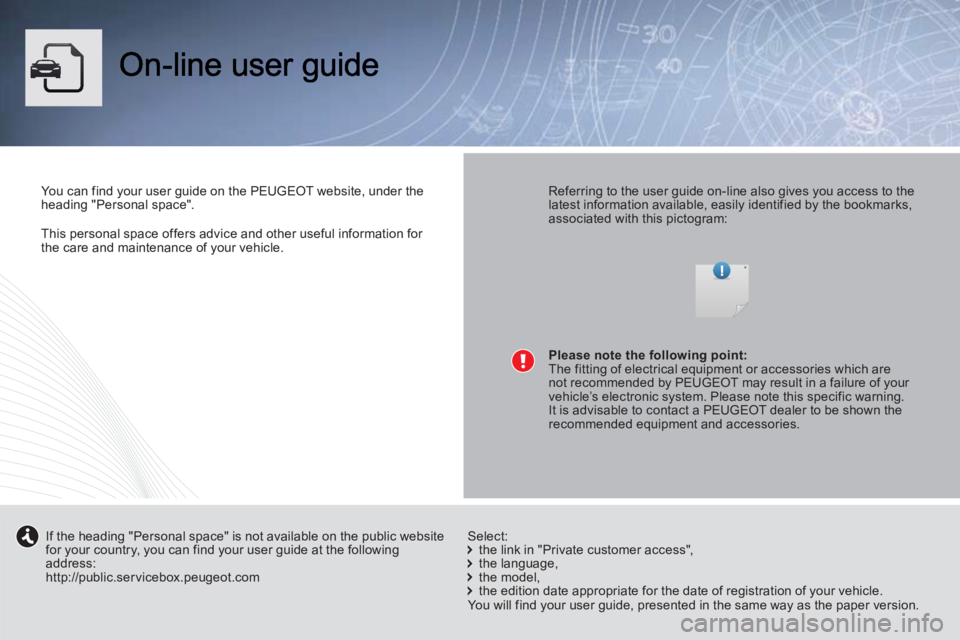
This personal space offers advice and other useful information for
the care and maintenance of your vehicle.
You can find your user guide on thePEUGEOTwebsite, under theheading "Personal space".
Referring to the user guide on-line also gives you access to thelatest information available, easily identified by the bookmarks, associated with this pictogram:
If the heading "Personal space" is not available on the public websitefor your country, you can find your user guide at the following address:http://public.servicebox.peugeot.com
the link in "Private customer access",
the language,
the model,
the edition date appropriate for the date of registration of your vehicle.
Please note the following point:
The fitting of electrical equipment or accessories which are
not recommended by PEUGEOT may result in a failure of your
vehicle’s electronic system. Please note this specific warning.
It is advisable to contact a PEUGEOT dealer to be shown the
recommended equipment and accessories.
Select:
You will find your user guide, presented in the same way as the paper version.
Page 28 of 364
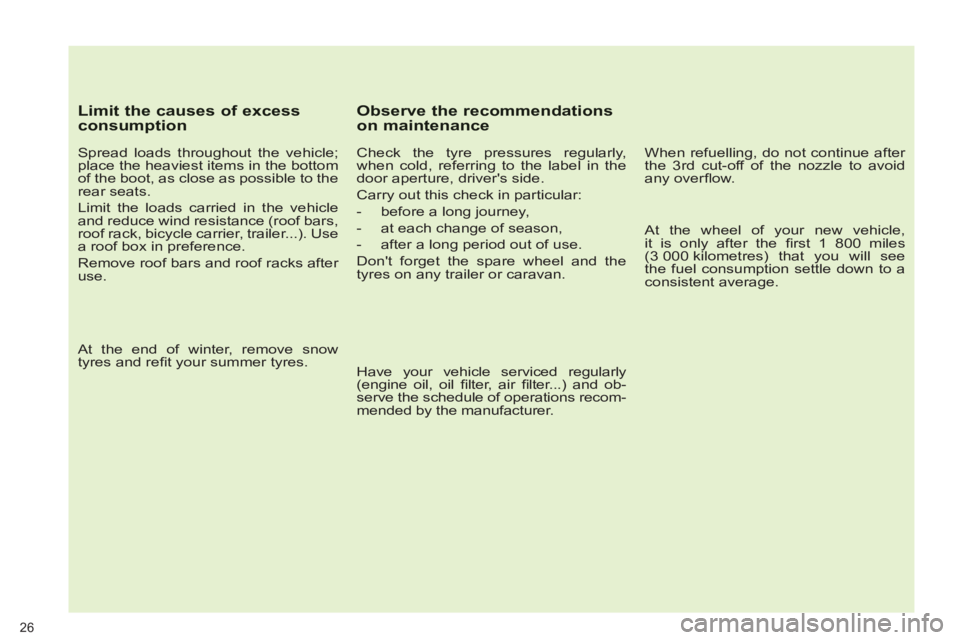
26
Limit the causes of excess consumption
Spread loads throughout the vehicle;
place the heaviest items in the bottom
of the boot, as close as possible to the
rear seats.
Limit the loads carried in the vehicle
and reduce wind resistance (roof bars,
roof rack, bicycle carrier, trailer...). Use
a roof box in preference.
Remove roof bars and roof racks after
use.
At the end of winter, remove snow
tyres and refi t your summer tyres.
Observe the recommendationson maintenance
Check the tyre pressures regularly,
when cold, referring to the label in the
door aperture, driver's side.
Carry out this check in particular:
- before a long journey,
- at each change of season,
- after a long period out of use.
Don't forget the spare wheel and the
tyres on any trailer or caravan.
Have your vehicle serviced regularly
(engine oil, oil fi lter, air fi lter...) and ob-
serve the schedule of operations recom-
mended by the manufacturer.
When refuelling, do not continue after
the 3 rd cut-off of the nozzle to avoid
any overfl ow.
At the wheel of your new vehicle,
it is only after the fi rst 1 800 miles
(3 000 kilometres) that you will see
the fuel consumption settle down to a
consistent average.
Page 59 of 364

CO
57
The air conditioning system
does not contain chlorine and
does not present any danger
to the ozone layer.
Recommendations for ventilation and air conditioning
REAR VENTILATION
ADJUSTMENT
After pressing the "REAR" button, turn
the adjustment dial of the rear side
vents to decrease or increase the fl ow
of air.
Take care not to obstruct the side vents
and the air outlets on the fl oor.
To shut off the fl ow of air, close the vents
and set the dial to 0. In order for these systems to be fully effective, follow the operation and
maintenance guidelines below:
�)
If the interior temperature remains very high after the vehicle has been
parked in the sun for a considerable time, fi rst ventilate the passenger
compartment for a few minutes.
Place the air fl ow control at a suffi cient level to provide an adequate renewal
of air in the passenger compartment.
�)
To obtain an even air distribution, take care not to obstruct the exterior air
intake grilles located at the base of the windscreen, the nozzles, the vents
and the air outlets, as well as the air extractor located in the boot.
�)
Use in preference the intake of exterior air as prolonged use of the air
recirculation may cause misting of the windows and side windows.
�)
Do not cover the sunshine sensor, located on the dashboard; this is used for
regulation of the automatic air conditioning system.
�)
Operate the air conditioning system for 5 to 10 minutes, once or twice a
month to keep it in good working order.
�)
Ensure that the passenger compartment fi lter is in good condition and have
the fi lter elements replaced regularly (refer to the "Checks" section).
We recommend the use of a combined passenger compartment fi lter. Thanks
to its second special active fi lter, it contributes to the purifi cation of the air
breathed by the occupants and the cleanliness of the passenger compartment
(reduction of allergic symptoms, bad odours and greasy deposits).
�)
The air conditioning uses power from the engine while operating. This results
in an increase in the vehicle's fuel consumption.
When towing at or near maximum capacity or on steep slopes in high ambient
temperatures, switching off the air conditioning saves engine power and so
improves towing capacity.
Condensation created by the air conditioning results in a discharge of water
under the vehicle when stationary, which is perfectly normal.
�)
To ensure correct operation of the air conditioning system, you are also advised
to have it checked regularly.
�)
If the system does not produce cold air, do not use it and contact a PEUGEOT
dealer or a qualifi ed workshop.
Page 161 of 364
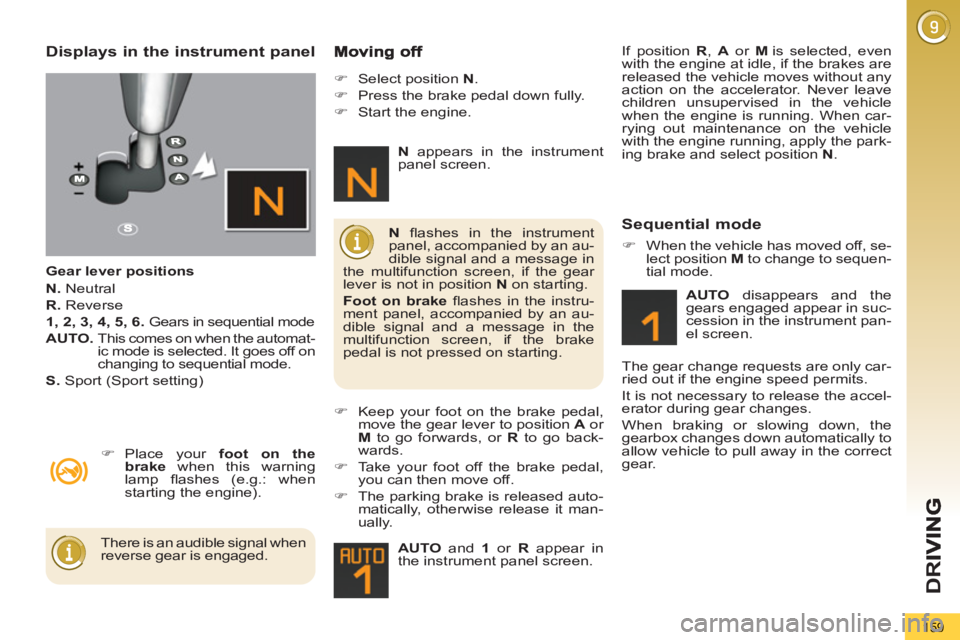
D
R
159
Displays in the instrument panel
Gear lever positions
N.
Neutral
R.
Reverse
1, 2, 3, 4, 5, 6.
Gears in sequential mode
AUTO.
This comes on when the automat-
ic mode is selected. It goes off on
changing to sequential mode.
S.
Sport (Sport setting)
�)
Place your foot on the
brake
when this warning
lamp fl ashes (e.g.: when
starting the engine).
�)
Select position N
.
�)
Press the brake pedal down fully.
�)
Start the engine.
�)
Keep your foot on the brake pedal,
move the gear lever to position A
or
M
to go forwards, or R
to go back-
wards.
�)
Take your foot off the brake pedal,
you can then move off.
�)
The parking brake is released auto-
matically, otherwise release it man-
ually.
AUTO
and 1
or R
appear in
the instrument panel screen.
N
fl ashes in the instrument
panel, accompanied by an au-
dible signal and a message in
the multifunction screen, if the gear
lever is not in position N
on starting.
Foot on brake
fl ashes in the instru-
ment panel, accompanied by an au-
dible signal and a message in the
multifunction screen, if the brake
pedal is not pressed on starting.
There is an audible signal when
reverse gear is engaged.
N
appears in the instrument
panel screen.
Sequential mode
AUTO
disappears and the
gears engaged appear in suc-
cession in the instrument pan-
el screen.
The gear change requests are only car-
ried out if the engine speed permits.
It is not necessary to release the accel-
erator during gear changes.
When braking or slowing down, the
gearbox changes down automatically to
allow vehicle to pull away in the correct
gear.
If position R
, A
or M
is selected, even
with the engine at idle, if the brakes are
released the vehicle moves without any
action on the accelerator. Never leave
children unsupervised in the vehicle
when the engine is running. When car-
rying out maintenance on the vehicle
with the engine running, apply the park-
ing brake and select position N
.
�)
When the vehicle has moved off, se-
lect position M
to change to sequen-
tial mode.
Page 165 of 364
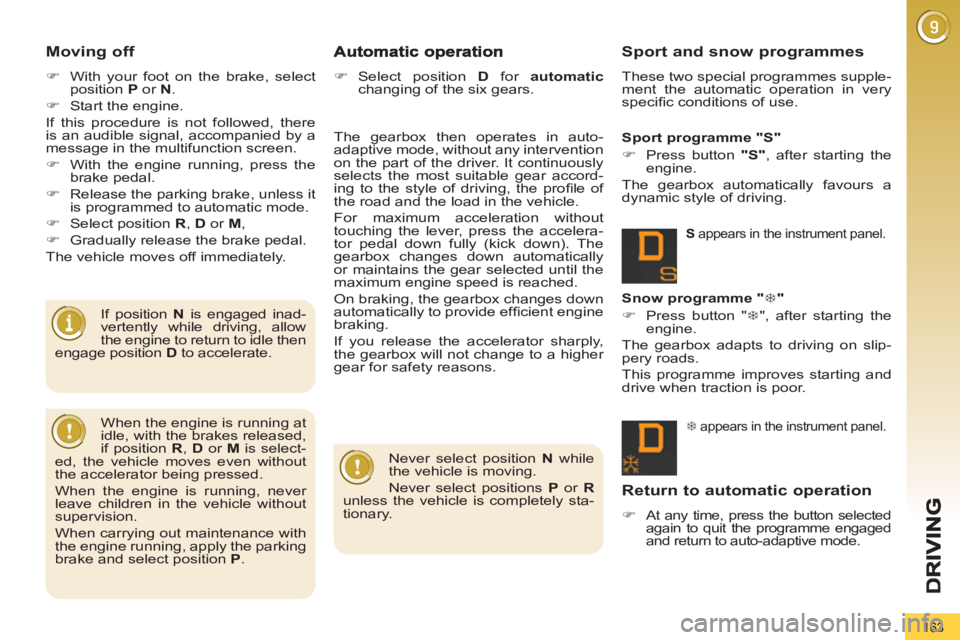
163
Moving off
�)
With your foot on the brake, select
position P
or N
.
�)
Start the engine.
If this procedure is not followed, there
is an audible signal, accompanied by a
message in the multifunction screen.
�)
With the engine running, press the
brake pedal.
�)
Release the parking brake, unless it
is programmed to automatic mode.
�)
Select position R
, D
or M
,
�)
Gradually release the brake pedal.
The vehicle moves off immediately.
If position N
is engaged inad-
vertently while driving, allow
the engine to return to idle then
engage position D
to accelerate. The gearbox then operates in auto-
adaptive mode, without any intervention
on the part of the driver. It continuously
selects the most suitable gear accord-
ing to the style of driving, the profi le of
the road and the load in the vehicle.
For maximum acceleration without
touching the lever, press the accelera-
tor pedal down fully (kick down). The
gearbox changes down automatically
or maintains the gear selected until the
maximum engine speed is reached.
On braking, the gearbox changes down
automatically to provide effi cient engine
braking.
If you release the accelerator sharply,
the gearbox will not change to a higher
gear for safety reasons.
�)
Select position D
for automatic
changing of the six gears.
�7
appears in the instrument panel.
Snow programme " �7
"
�)
Press button " �7
", after starting the
engine.
The gearbox adapts to driving on slip-
pery roads.
This programme improves starting and
drive when traction is poor.
S
appears in the instrument panel.
Sport programme "S"
�)
Press button "S"
, after starting the
engine.
The gearbox automatically favours a
dynamic style of driving.
Never select position N
while
the vehicle is moving.
Never select positions P
or R
unless the vehicle is completely sta-
tionary.
When the engine is running at
idle, with the brakes released,
if position R
, D
or M
is select-
ed, the vehicle moves even without
the accelerator being pressed.
When the engine is running, never
leave children in the vehicle without
supervision.
When carrying out maintenance with
the engine running, apply the parking
brake and select position P
.
Sport and snow programmes
These two special programmes supple-
ment the automatic operation in very
specifi c conditions of use.
Return to automatic operation
�)
At any time, press the button selected
again to quit the programme engaged
and return to auto-adaptive mode.
Page 169 of 364
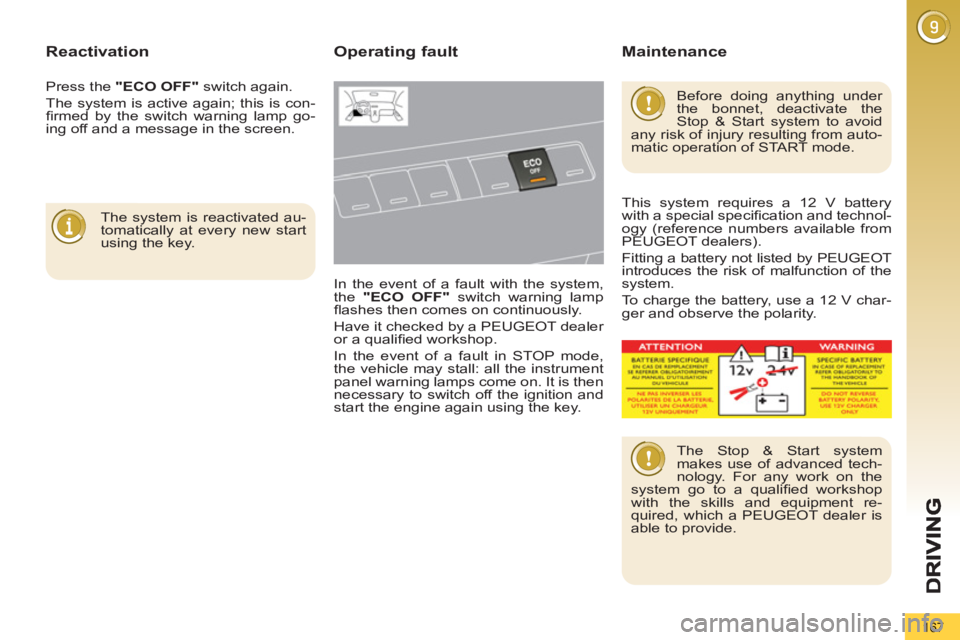
167
Reactivation
The system is reactivated au-
tomatically at every new start
using the key.
Operating fault
In the event of a fault with the system,
the "ECO OFF"
switch warning lamp
fl ashes then comes on continuously.
Have it checked by a PEUGEOT dealer
or a qualifi ed workshop.
In the event of a fault in STOP mode,
the vehicle may stall: all the instrument
panel warning lamps come on. It is then
necessary to switch off the ignition and
start the engine again using the key.
Before doing anything under
the bonnet, deactivate the
Stop & Start system to avoid
any risk of injury resulting from auto-
matic operation of START mode.
The Stop & Start system
makes use of advanced tech-
nology. For any work on the
system go to a qualifi ed workshop
with the skills and equipment re-
quired, which a PEUGEOT dealer is
able to provide.
Maintenance
This system requires a 12 V battery
with a special specifi cation and technol-
ogy (reference numbers available from
PEUGEOT dealers).
Fitting a battery not listed by PEUGEOT
introduces the risk of malfunction of the
system.
To charge the battery, use a 12 V char-
ger and observe the polarity. Press the "ECO OFF"
switch again.
The system is active again; this is con-
fi rmed by the switch warning lamp go-
ing off and a message in the screen.
Page 181 of 364
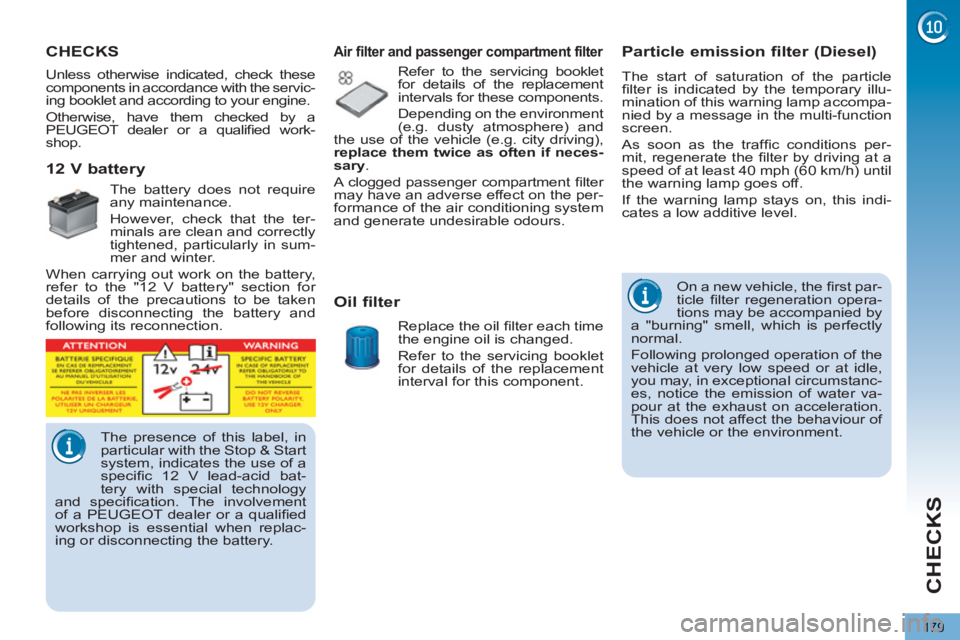
CHECKS
179
Particle emission filter (Diesel)
The start of saturation of the particle
fi lter is indicated by the temporary illu-
mination of this warning lamp accompa-
nied by a message in the multi-function
screen.
As soon as the traffi c conditions per-
mit, regenerate the fi lter by driving at a
speed of at least 40 mph (60 km/h) until
the warning lamp goes off.
If the warning lamp stays on, this indi-
cates a low additive level.
On a new vehicle, the fi rst par-
ticle fi lter regeneration opera-
tions may be accompanied by
a "burning" smell, which is perfectly
normal.
Following prolonged operation of the
vehicle at very low speed or at idle,
you may, in exceptional circumstanc-
es, notice the emission of water va-
pour at the exhaust on acceleration.
This does not affect the behaviour of
the vehicle or the environment.
CHECKS
Unless otherwise indicated, check these
components in accordance with the servic-
ing booklet and according to your engine.
Otherwise, have them checked by a
PEUGEOT dealer or a qualifi ed work-
shop.
The presence of this label, in
particular with the Stop & Start
system, indicates the use of a
specifi c 12 V lead-acid bat-
tery with special technology
and specifi cation. The involvement
of a PEUGEOT dealer or a qualifi ed
workshop is essential when replac-
ing or disconnecting the battery.
12 V battery
The battery does not require
any maintenance.
However, check that the ter-
minals are clean and correctly
tightened, particularly in sum-
mer and winter.
When carrying out work on the battery,
refer to the "12 V battery" section for
details of the precautions to be taken
before disconnecting the battery and
following its reconnection.
Air filter and passenger compartment filter
Refer to the servicing booklet
for details of the replacement
intervals for these components.
Depending on the environment
(e.g. dusty atmosphere) and
the use of the vehicle (e.g. city driving),
replace them twice as often if neces-
sary
.
A clogged passenger compartment fi lter
may have an adverse effect on the per-
formance of the air conditioning system
and generate undesirable odours.
Oil filter
Replace the oil fi lter each time
the engine oil is changed.
Refer to the servicing booklet
for details of the replacement
interval for this component.
Page 182 of 364
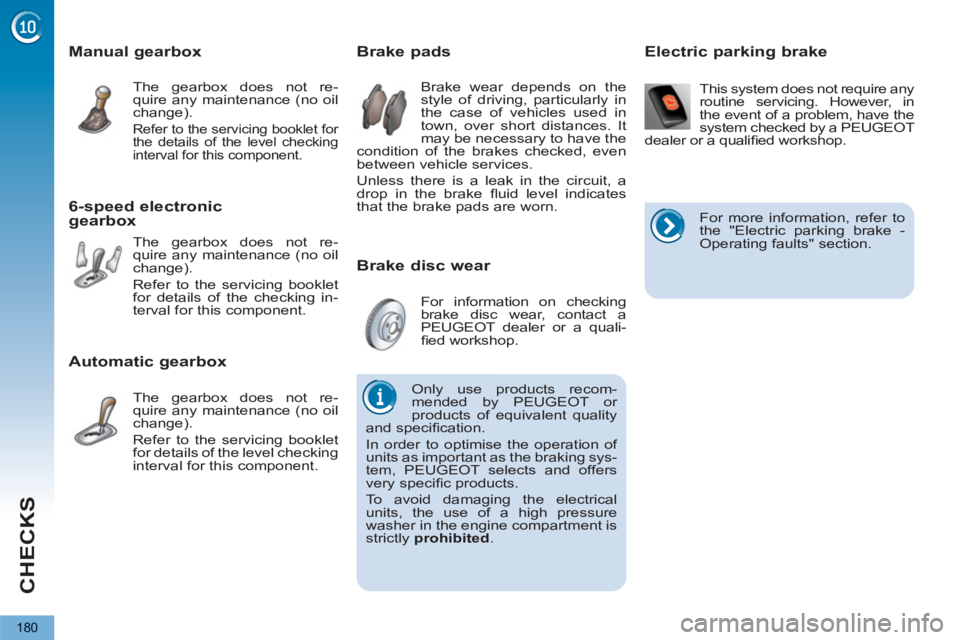
CHECKS
180
Brake disc wear
Brake pads
Brake wear depends on the
style of driving, particularly in
the case of vehicles used in
town, over short distances. It
may be necessary to have the
condition of the brakes checked, even
between vehicle services.
Unless there is a leak in the circuit, a
drop in the brake fl uid level indicates
that the brake pads are worn.
For information on checking
brake disc wear, contact a
PEUGEOT dealer or a quali-
fi ed workshop.
Manual gearbox
The gearbox does not re-
quire any maintenance (no oil
change).
Refer to the servicing booklet for
the details of the level checking
interval for this component.
6-speed electronic
gearbox
The gearbox does not re-
quire any maintenance (no oil
change).
Refer to the servicing booklet
for details of the checking in-
terval for this component.
Automatic gearbox
The gearbox does not re-
quire any maintenance (no oil
change).
Refer to the servicing booklet
for details of the level checking
interval for this component. This system does not require any
routine servicing. However, in
the event of a problem, have the
system checked by a PEUGEOT
dealer or a qualifi ed workshop.
Electric parking brake
Only use products recom-
mended by PEUGEOT or
products of equivalent quality
and specifi cation.
In order to optimise the operation of
units as important as the braking sys-
tem, PEUGEOT selects and offers
very specifi c products.
To avoid damaging the electrical
units, the use of a high pressure
washer in the engine compartment is
strictly prohibited
.
For more information, refer to
the "Electric parking brake -
Operating faults" section.